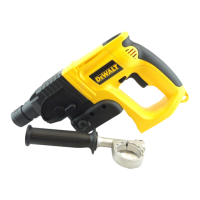3
SECTION A: GENERAL SAFETY RULES
SECTION A: GENERAL SAFETY RULES
SAFETY INSTRUCTIONS
When using power tools, always observe the safety regulations applicable in your
country to reduce the risk of fire, electric shock and personal injury. Read the
following safety instructions before attempting to operate these products. Keep
these instructions in a safe place.
General
1. Keep work area clean. Cluttered areas and benches can cause accidents.
2. Consider work area environment. Do not expose power tools, including
chargers, to high humidity or rain. Keep work area well lit. Do not use power
tools, including all cordless tools and chargers, in the presence of flammable
liquids or gases.
3. Guard against electric shock. Prevent body contact with earthed surfaces
(e.g. pipes, radiators, cookers and refrigerators).
4. Keep children away. Do not let children come into contact with the tool or
extension cord. Keep all people away from the work area.
5. Extension cords for outdoor use. When the tool is used outdoors, always
use extension cords intended for outdoor use and marked accordingly.
6. Store idle tools. When not in use, power tools must be stored in a dry place
and locked up securely, out of the reach of children.
7. Dress properly. Do not wear loose clothing or jewellry. They can be caught in
moving parts. Preferably wear rubber gloves and non-slip footwear when
working outdoors. Wear protective hair covering to keep long hair out of the
way.
8. Wear safety goggles. Also use a face or dust mask in case the operations
produce dust or flying particles.
9. Be aware of maximum sound pressure. Take appropriate measures for
the protection of hearing if the sound pressure of 85dB(A) is exceeded.
10. Secure workpiece. Use clamps or a vice to hold the workpiece.
It is safer and it frees both hands to operate the tool.
11. Do not overreach. Keep proper footing and balance at all times.
12. Avoid unintentional starting. Do not carry the plugged-in tool with a finger
on the switch. Be sure that the switch is released when plugging in.
13. Stay alert. Watch what you are doing. Use common sense. Do not operate
the tool when you are tired.
14. Disconnect tool. Shut off power and wait for the tool to come to a complete
standstill before leaving it unattended. Unplug the tool when not in use, before
servicing or changing accessories.
15. Remove adjusting keys and wrenches. Always check that adjusting keys
and wrenches are removed from the tool before operating the tool.
16. Use appropriate tool. Do not force small tools or attachments to do the job
of a heavy-duty tool. The tool will do the job better and safer at the rate for
which it is intended. The use of any accessories or attachments other than the
ones recommended in this instruction manual may induce a risk of personal
injury.
17. Do not abuse cord. Never carry the tool by its cord or pull the cord to
disconnect it from the socket. Keep the cord away from heat, oil and sharp
edges.
18. Maintain tools with care. Keep tools in good condition and clean for better
and safer performance. Follow the instructions for maintenance and changing
accessories. Inspect tool cords at regular intervals and, if damaged, have them
repaired by an authorised D
EWALT Repair Centre. Inspect extension cords
periodically and replace them if damaged. Keep all controls dry, clean and free
from oil and grease.
19. Check damaged parts. Before using the tool, carefully check it for damage
to ensure it will operate properly and perform its intended function. Check for
misalignment and seizure of moving parts, breakage of parts and any other
conditions that may affect its operation. Have damaged guards or other
defective parts repaired or replaced as instructed. Do not use the tool if switch
is defective. Have the switch replaced by an authorised D
EWALT Repair Centre.
20. Have your tool repaired by an authorised D
EWALT Repair Centre.
This power tool is in accordance with the relevant safety regulations. To avoid
danger, electric appliances must only be repaired by qualified technicians.
21. These tools are not intended for use by young children or infirm persons
without supervision. Young children should be supervised to ensure that they do
not play with these tools.

